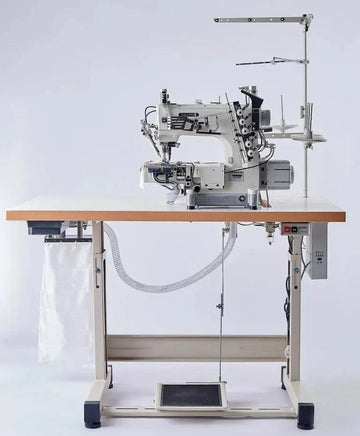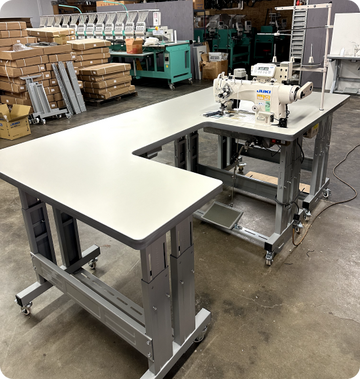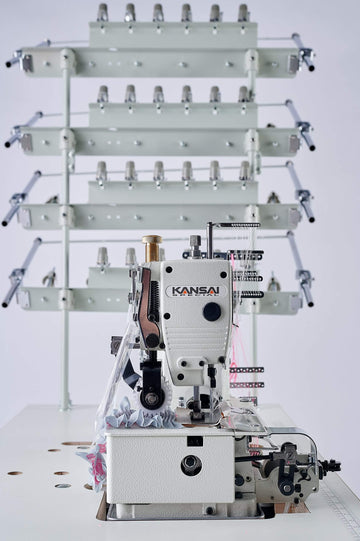Pixels and bytes have long penetrated all spheres of human life, so it’s not surprising that new technologies keep making their way into the textile and apparel industry. What seemed impossible just several years ago is now redefining the way our garments are designed, produced, and even worn. Let’s see how sewing technologies have changed textile manufacturing, making clothing production more efficient, accurate, and environmentally friendly.
History and Evolution of Sewing Technologies
Sewing was invented hundreds of years ago. According to various estimates, it appeared around 30,000 BC, when people began to use bone needles, fishing hooks, and animal sinew to make clothing and protective wear from furs. Eventually, bone needles were replaced with the metal ones, and sinew – with spun threads from linen, wool, silk, and cotton. Sewing became more complex and professional approximately in the 15th century, when tailors started to use different tools (thread-winding systems, pins, bodkins, awls, etc.) and stitching techniques to craft not only functional but also visually appealing clothes.
Sewing Machine Innovations
The history of sewing machines has its roots in the 18th century. Here are the key milestones in their development:
-
1790: Thomas Saint designed and patented the first machine, although it still was not built.
-
1830: Barthélemy Thimonnier designed and created a wooden sewing machine used for sewing French army uniforms.
-
1846: Elias Howe introduced the first lockstitch sewing machine.
-
1850s - 1900s: mass production of sewing machines for commercial, industrial, and domestic use.
-
1889: Singer manufactured the first electric machine model.
-
1940s - 1960s: emergence of specialized embroidery, zigzag, and overlocking machines.
-
1978: Brother manufactured the first computerized machine with advanced features and programmable stitch patterns.
-
1980s - 1990s: further development of sewing machines (LCD displays and automatic threading were introduced).
-
2000s - present: integration of smart sewing machine technology (USB ports, touchscreens, stitch customization, and internet connectivity).
Read Also: How to Start a Garment Manufacturing Business?
Modern Sewing and Stitching Technology
Modern machines are packed with a wide range of advanced sewing technologies that enhance their functionality and make the operational process more convenient. These smart systems can perform complex sewing operations with high accuracy and minimum human intervention. The most advanced new technology sewing machines boast such features:
-
Automatic needle threaders and thread cutters
-
Hundreds of stitch patterns, including programmable ones
-
Automatic tension adjustment
-
Automatic fabric thickness recognition for subsequent selection of the appropriate sewing mode
-
Voice control and touchscreen interfaces
-
AI-integrated sensors for defect detection
-
Automatic fabric cutting
-
Integration of Bluetooth and Wi-Fi technologies (first patented by Juki)
Technological Innovations in the Textile and Apparel Industry
Technological advances in textile industry and garment production have driven a true revolution in the operational processes. The most notable innovations include:
-
CAD software for creating garment designs and visualizing fabric placement
-
3D tailoring technology and virtual sampling to see how a clothing item looks, fits, and moves before creating its physical sample
-
PLM systems for seamless communication across departments
-
Cloud-based collaboration tools
-
Integration of IoT devices to collect data from physical assets
-
Use of blockchain technology in supply chains
-
AI-powered apparel technology, allowing for efficient design creation and product planning
Impact of Advanced Apparel Industry Technology on Manufacturing Efficiency and Quality
Innovations in apparel production and advanced sewing technology solutions bring many benefits for garment manufacturers, including:
-
Higher production speed due to process automation
-
Improved sewing accuracy and precision
-
Consistent product quality
-
Reduced dependence on human power
-
Minimized number of errors and defective products
-
Lower operational costs
Sustainability and Eco-Friendly Advancements in Technology Apparel Industry
Manufacturers engaged in the apparel industry are actively embracing innovative sustainability practices to minimize their environmental impact and meet the demand for eco-friendly goods. Here’s what they do to go greener:
-
Reduce fabric waste and emissions through digital product sampling and virtual prototyping
-
Opt for bio-based, recycled fabrics
-
Invest in energy-efficient equipment and renewable electricity sources
-
Use waterless dyeing technologies to reduce water consumption
-
Switch to recycled or biodegradable packaging instead of plastic bags
Future Trends and Outlook
The future of sewing technologies is very promising. With more and more innovations entering the industry, we can expect further advancements in automation systems and robotic garment assembly. Robotics is projected to double by 2030, while the market for automated sewing solutions is forecast to grow from $25 to $45 billion over the same period. Artificial intelligence will also find a greater application at each stage of the garment production, from trend forecasting and design creation to inventory planning. Other technological advancements will involve personalized clothing manufacturing, sustainability practices, and enhanced software integration.
Conclusion
From yearly sewing innovations of the 19th century to fully automated machines, computerized devices, and AI-powered technologies used today, the textile and apparel industry has continually evolved to enhance its operational efficiency and quality.
Seeking advanced sewing solutions for your business or personal needs? Welcome to Prizzi – a trusted supplier of feature-packed sewing machines for industrial, commercial, and domestic use. We also offer custom tables for over 4,000 machine models, each comes with a quality seal of approval and a lifetime warranty. We will be happy to see you at 1818 Floradale Avenue, South El Monte, California. In case you are not in Los Angeles County, browse our offerings online or contact us by phone.
Co-Owner at Prizzi Sewing Machine Co.
Expert in sewing factory workflow optimization











